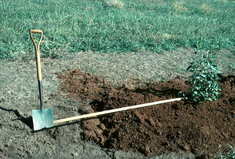 Blueberries are not native to Kansas but will grow in the eastern half of the state with good preparation. They are related to azaleas and rhododendrons and require an acid pH, preferably 4.8 to 5.2. Blueberries do not have root hairs, so watering and mulching is important. It is best to start planting preparations a year ahead of time to allow for pH adjustment, weed control, and the addition of organic matter. The first step is a soil test to determine how much the pH needs to be reduced. For a pH up to 5.5, the addition of sphagnum peat moss at the rate of 2 cubic feet per 100 square feet will be adequate. For a pH 5.5 to 6.0, add 1 pound of sulfur per 100 square feet of bed in addition to the peat moss. For a pH 6.0 to 6.5, add 1.5 pounds of sulfur per 100 square feet of bed. For pH levels above 6.5, use 2 pounds of sulfur per 100 square feet of bed and double the amount of sphagnum peat moss suggested earlier. Do not use aluminum sulfate to correct a high pH because excessive levels of aluminum can be toxic to blueberries. For each 0.5 movement up the pH scale from 6.5, add an additional pound of sulfur. Sulfur can be applied as a dust, but pelletized sulfur is much easier to spread. Treat only the row. Row width should be 8 feet. Blueberries are normally spaced about 5 feet within the row. Sulfur takes time to react, so allow as much time as possible between sulfur application and planting. Blueberries will bear more if you plant more than one variety. Recommended varieties vary, but you may want to try Bluecrop because it is adaptable. Patriot also seems to do well. You may want to try some other varieties. Blueberries should be mulched. Sawdust is the traditional material, but straw and wood chips will work as well. Mulch to a depth of about 3 inches. Blueberries must be irrigated. Soils should be kept most but never waterlogged. Adding peat moss to the planting row will elevate the planting bed enough that standing water should not be an issue. An elevated bed will dry out more quickly, so there must be a means of adding water. Trickle irrigation works well. Watering twice a week during the summer with enough water to wet the soil 8 inches deep should be sufficient except under extreme heat. Watering once a week may be enough during the cooler spring and fall weather. As you might guess, there is more to growing blueberries than can be included in a short article. Dr. Art Gaus from the University of Missouri shared this instruction sheet on how to grow blueberries more than 25 years ago. It is still excellent information on blueberry culture. You can access it by going to: http://hnr.k-state.edu/doc/extension-gardening-tips/Blueberry_Production.pdf Blueberries require commitment. Anything less than excellent preparation and care will result in failure. (Ward Upham) 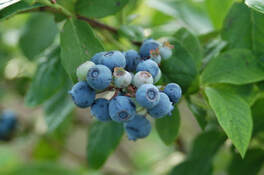 Growing blueberries in containers is becoming more popular. Chosen varieties are usually half-high plants that are a cross between highbush and lowbush blueberry species. Plants can be as small as 18 inches tall and wide (Top Hat), but typically are larger. Here are several tips for producing container grown blueberries: Acid soil pH: Blueberries need an acid pH between 4.8 and 5.2. Sphagnum peat moss is very acid and often used in large quantities in soil mixes for acid-loving plants. In fact, blueberries can be grown in peat moss alone if nutrients are provided but that is an involved process. A 50/50 mix of peat moss and potting soil is recommended. This will provide nutrients and weight so the plant is less likely to blow over in wind. Container size: Though containers as small as 2 gallons can be used for half-high blueberries, a larger container will be more stable in the wind and provide a larger moisture reserve during hot, dry weather. Watering: Blueberries do not have root hairs, so they are not efficient in picking up water. Potting soil should be kept moist. This will likely be the most challenging aspect of growing blueberries in containers. A large container will not need to be watered as frequently as a small one. Winter care: Though plants are winter hardy, the roots are not. Move pots into an unheated, attached garage or bury them in the soil or mulch enough to bury the pot in early November. Water them periodically during the winter. Use your finger to determine if the soil is moist one inch deep. If not, then water until some flows out the bottom of the pot. Varieties: Though blueberries will produce some fruit if only a single variety is grown, two varieties will increase the potential fruit crop. Suggested varieties include Top Hat and Northsky. Each should reach about 18 inches high, though Northsky will likely grow wider than Top Hat. Northblue is another choice that should produce more fruit than either Top Hat or Northsky but should reach 2 to 3 feet high. North Country is intermediate in size at 18 to 24 inches high and should produce a moderate amount of fruit. Wind protection: Wind protection will decrease the amount of water these plants need and reduce the chances of leaf scorch. Exposure: Blueberries do best with a minimum of 6 to 8 hours of sunlight a day. Try a northern or eastern exposure that is protected from the wind. (Ward Upham) 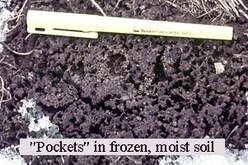 As mentioned in a companion article in this newsletter, the best time to overseed cool-season grasses such as tall fescue and Kentucky bluegrass is September because the turf has more time to mature before crabgrass germination in the spring and the heat stress of summer. However, dormant seeding of turfgrass is sometimes used to help fill in bare spots of lawns that weren't overseeded in the fall. Dormant seeding is normally not used to seed large areas because of the possibility of erosion before the seed emerges and becomes mature enough to hold the soil. Dormant overseeding is usually done during the winter (December through February) when it is too cold for germination to take place. Spring seedings done in March can be just as successful as dormant seeding, but spring rains may delay plantings. As with any seeding program, it is vital that good seed-soil contact is achieved. There are several methods that are commonly used in dormant seeding. One method is to seed when there has been a light snowfall of up to an inch over unfrozen soil. This is shallow enough that bare spots can still be seen. Spread seed by hand on areas that need thickening up. As the snow melts it brings the seed into good contact with the soil where it will germinate in the spring. Another method is dependent on the surface of the soil being moist followed by some freezing weather. As moist soil freezes and thaws, small pockets are formed on the wet, bare soil which are perfect for catching and holding seed. As the soil dries, the pockets collapse and cover the seed. If dry enough and the soil is unfrozen, seed can be applied to bare spots and then raked in to ensure good seed/soil contact. With any of the above methods, seed germinates in the spring as early as possible. There will be limitations on what herbicides can be used for weed control. Tupersan (siduron) can be used as a crabgrass preventer on new seedings even before they have come up. Also dithiopyr, found in Hi-Yield Turf and Ornamental Weed & Grass Stopper and Bonide Crabgrass & Weed Preventer, can be used on tall fescue, Kentucky bluegrass, and perennial ryegrass two weeks after germination. Dithiopyr is longer lasting and more effective than siduron. Other preemergence herbicides available to homeowners require that the turf be well established before application. (Ward Upham) 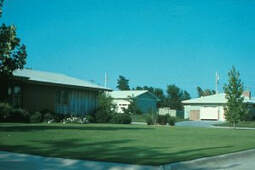 People often wonder why we recommend seeding cool-season grasses such as tall fescue and Kentucky bluegrass in the fall. It would seem that the spring would be the more natural time for seeding because the entire growing season is available for the grass to become established before the turf has to deal with winter. Actually there are a number of reasons that tend to make fall seedings more successful. The soils are warmer in the fall. Warm soils mean less time required for germination and growth so the grass becomes established more quickly. I have seen tall fescue seeded in the last week of August come up in four days. Now, you had to be on your hands and knees to see it but it was up. Tall fescue seeded in the spring may take well over a week to come up and the time required to become established is much longer. Weeds are less of a problem in the fall. The major weed problems in the fall tend to be the broadleaves such as chickweed, henbit or dandelion. Turf seeded in early September is usually thick enough by the time these broadleaves germinate that often there is not much weed invasion. Even if there is some invasion by broadleaves, the turf should be mature enough by early November that mild broadleaf herbicides can be applied. In the spring, our major weed problems are the annual grasses such as crabgrass. Since the spring-seeded turf is slow to mature, there are often thin areas that are easily invaded by these grassy weeds. If this invasion occurs, the weeds are better adapted to our hot, summer conditions than our cool-season grasses and so the weeds tend to take over. The number of chemicals that can be used on young turf is limited, and so these grasses become more of a problem. One of the preemergence herbicides that can be used on young grasses is dithiopyr (Dimension). It is found in Hi-Yield Turf and Ornamental Weed & Grass Stopper and Bonide Crabgrass & Weed Preventer and can be used on tall fescue, Kentucky bluegrass, and perennial ryegrass two weeks after germination. Summer is the hardest time of the year for cool-season grasses; not the winter. Summertime is very difficult because our cool-season grasses do not have the heat or moisture stress tolerance that our warm-season grasses such as buffalo, zoysia and Bermuda have. Therefore they tend to become weakened in the summer which makes them more susceptible to disease and other stresses. Spring-seeded cool-season grasses are less mature and therefore less able to tolerate these stresses. Seeding cool-season grasses in the spring can be successful but is more difficult to pull off than fall seedings. If you have a choice, always opt for seeding cool-season grasses in the fall. (Ward Upham) 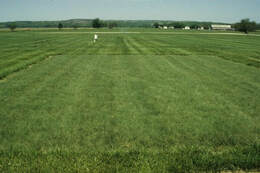 General Comments Buffalograss has become more popular in recent years due to its reputation as a low-maintenance grass. Buffalograss can survive with less water and fertilizer than our other turfgrasses. March Spot treat broadleaf weeds if necessary. The most important treatment for broadleaf weeds should be in late October to early November well after the buffalograss is dormant. Treatments are much more effective then than in the spring as the weeds are smaller and the weeds are sending energy, as well as the herbicide, to the roots. Treatments in March are to take care of any “escapes” missed in the fall spraying. Spray early enough in March that the buffalograss is still dormant. Look at the base of the plants to make sure there is no green. Try to treat on a day that is 50 degrees F or warmer. Rain or irrigation within 24 hours of application will reduce effectiveness. Use a combination product such as Trimec, Weed-B-Gon or Weed-Out. Weed Free Zone is also good and will give quicker results under cool conditions. April Apply crabgrass preventer between April 1 and April 15, or apply preventer when the eastern redbud is in full bloom. If using a product with prodiamine (Barricade), apply two weeks earlier. Crabgrass preventers must be watered in before they will work. Avoid using broadleaf herbicides as the buffalograss is greening up as injury can result. The buffalograss will not be killed but growth will slow making the buffalograss less competitive with weeds. June Fertilize with 1 lb. of nitrogen per 1,000 square feet during June. More applications will give a deeper green color. If it is felt that a second application is needed, apply in July. If grubs have been a problem in the past, apply a product containing imidacloprid by mid July. Imidacloprid can be applied as early as mid May if there are problems with billbugs or May beetle grubs. These products kill the grubs before they cause damage. They are effective and safe but must be watered in before they become active. Again, treat only if grubs have been a problem in the past. Note that the whole area may not need to be treated. The beetles that lay the eggs for the grubs are attracted to lights and moist soil and those areas are most likely to be infested. Late-July through August If you see grub damage, apply a grub killer. If imidacloprid has been applied or if grubs have not been a problem in the past, this should not be necessary. Grub killers must be watered in immediately. Late October to Early November Spray for broadleaf weeds if they are a problem. Look carefully as our winter annuals such as chickweed and henbit are small and easily overlooked. Use a product that contains 2,4-D as it increases effectiveness on dandelions. Treat on a day that is at least 50 degrees F. Rain or irrigation within 24 hours reduces effectiveness. Use the rates listed on the label for all products mentioned. (Ward Upham) 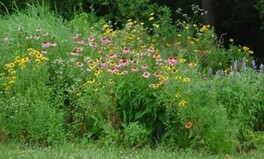 Native grasses and many native wildflowers do well within a wide pH range. Any pH between 5.5 and 8 should work. Just make sure the area receives at least 8 hours of sun a day. It is better to choose a blend of grasses and wildflowers rather than a single species. Companies that provide regional blends include Sharp Brothers, Stock Seed and Wildseed Farms. These plants do not take root and grow well in areas that already have established plants. Existing vegetation should be killed before seeding. Follow the following steps to increase the chances of success. - Control perennial weeds by using a product containing glyphosate. - Using glyphosate the fall before planting makes soil preparation easier the following spring - Adjust pH and fertilize according to soil test before planting. - The seedbed should be firm so that a boot heel sinks in no more than ½ inch. - The goal is good seed/soil contact. - Can mix seed with damp sand (4:1 sand/seed) for more uniform coverage with a drop seeder or whirlybird spreader. - The seed should be raked in about 1/4" deep. It is best if the seedbed is firmed up by using roller or driving over the area with a riding lawn mower. Don’t mulch. - Keep seed moist while the seed is germinating (3 to 4 times per week, if possible). Slowly back off watering as plants develop. What about planting dates? Warm-season grasses and most prairie flowers should be seeded between April 1 and May 15. To control any remaining living vegetation, spray with a product containing glyphosate, wait a week and plant. Make sure the soil temperature is at least 60 degrees before planting. Soil thermometers are often available in garden centers, hardware stores and auto stores (they are used to test air temperatures from air conditioners as well as in gardens). Hand weeding can help but must be done with care to avoid uprooting small prairie flowers. Mowing as high as possible can help control fast growing weeds while preserving most of the foliage on the prairie flower. (Ward Upham) 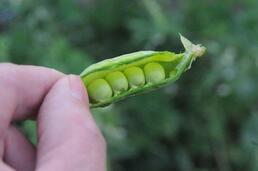 If you are tired of winter and hunger for spring, try planting peas as soon as the soil dries and the soil temperature reaches 40 degrees. There are several types of peas we can plant in Kansas. Probably the most common is the shelling pea and the old standard in this group is Little Marvel. Though Little Marvel is still on our recommended list, we have a number of others that do well including Green Arrow, Knight, Maestro, Burpeeana and Mr. Big. All of these are early maturing types that allow us to harvest a crop before the hot weather arrives and stops production. Snow peas are those commonly used in stir-fry that have a crisp edible pod. Recommended varieties include Dwarf Grey Sugar and Mammoth Melting Sugar. Sugar snap peas resemble shelling peas but have a thick, fleshy pod and can be eaten fresh, steamed or cooked. Like snow peas, they are not shelled but eaten pod and all. We recommend Sugar Bon, Sugar Ann, Super Sugar Snap and Sugar Sprint. Peas should be planted shallow, about one-half inch deep, to encourage rapid germination and emergence. Seed in the row should be spaced 2 inches apart. Many people often plant two rows 6 to 8 inches apart so the floppy plants can support one another. For some older varieties, this may not be enough. They may need trellising to support the growing vines. Fencing may be needed to keep rabbits away. (Ward Upham) 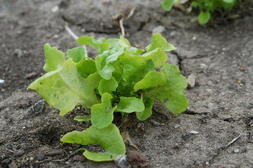 Though lettuce is most often planted directly from seed in late March to early April, it can be started from transplants. Transplants allow lettuce to mature earlier so that it escapes the excessive heat that can lead to a strong flavor and bitterness. Seed should be started four to five weeks before transplanting. Because transplants are planted at the same time as direct seeding, now would be a good time to begin. Use a seed starting mix and plant shallow as lettuce requires light for germination. A soil media temperature of 60 to 68 degrees will encourage germination. Watch the media temperature carefully, as seed can enter a thermal dormancy if germination temperatures are excessive. Also, a cooler temperature of 55 to 60 degrees should be used once the plants emerge. Time to maturity varies depending on the type of lettuce, with leaf lettuce being the quickest, followed by Bibb, romaine, and buttercrunch lettuce. Head or crisphead lettuce is the slowest and is least likely to mature before becoming bitter. Spacing also varies with type. Leaf lettuce plants are spaced 4 to 6 inches apart, buttercrunch, Bibb, and romaine are set at 6 to 8 inches and head lettuce should be at least 8 inches apart in the row. Lettuce does not have an extensive root system and requires regular watering if rainfall is lacking. Fertilize before planting according to soil test. Plants should also be sidedressed when about 1/3 grown. Sidedressing is done with fertilizers that have more nitrogen than phosphorus and potassium. Use 1/3 cup of nitrate of soda (16-0-0) or 1/4 cup of a 27-3-3, 29-5-4 or similar fertilizer per 10 feet of row. The latter fertilizers are lawn fertilizers but will work well for sidedressing as long as they do not contain weed killers or weed preventers. (Ward Upham) |
AuthorsCynthia Domenghini runs the Horticulture Response Center in the Department of Horticulture and Natural Resources at Kansas State University. Other contributors include K-State Extension Specialists. Archives
March 2024
Categories
All
|
| K-State Research and Extension Horticulture Newsletter |
|
 RSS Feed
RSS Feed
